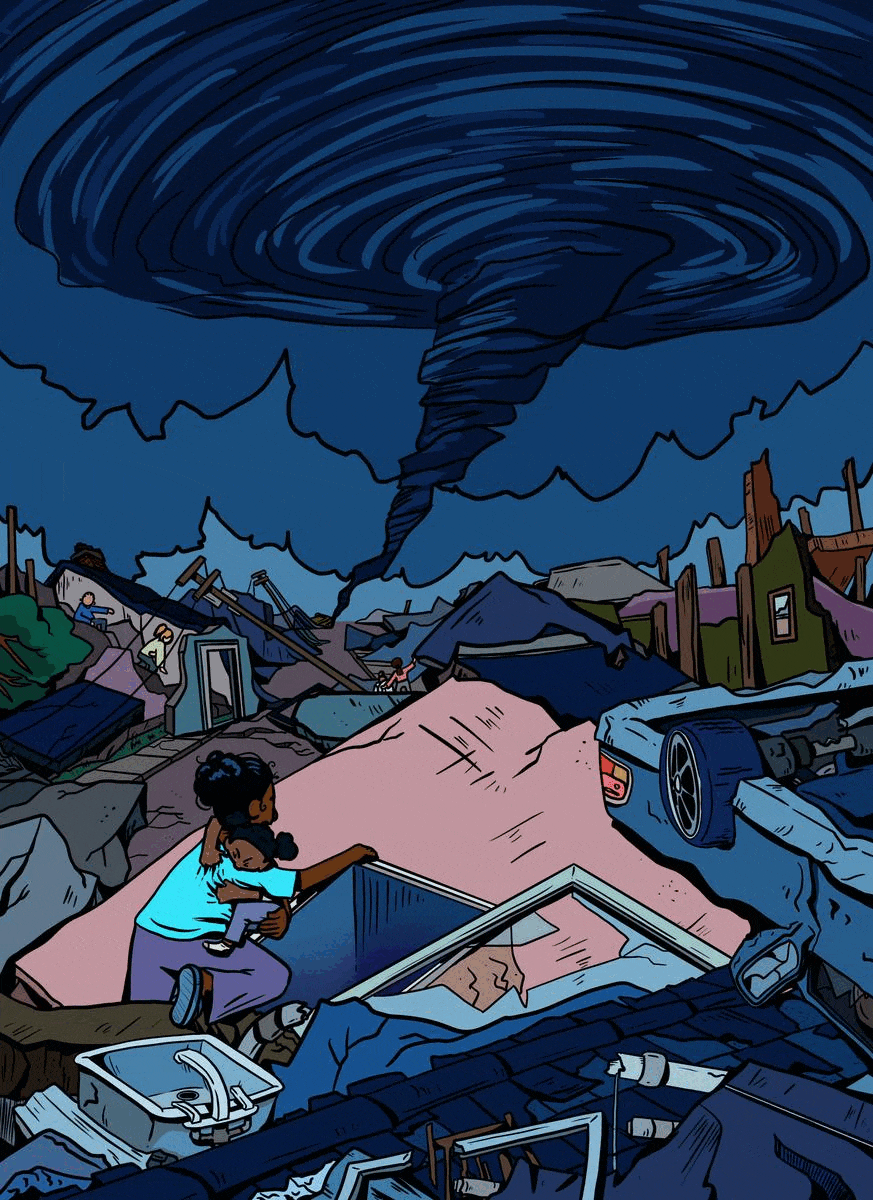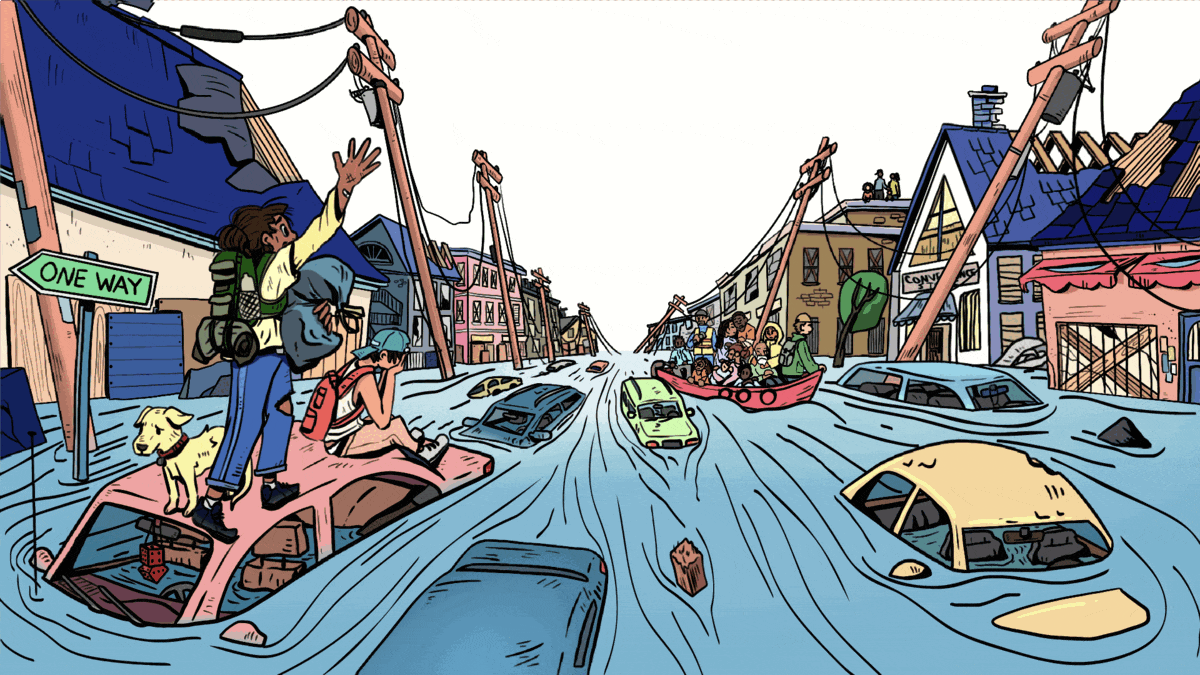Climate change is a global phenomenon that affects everyone on the planet – but it does not affect everyone equally. The consequences of climate change are as devastating as they are wide-ranging. From extreme heat to severe cold, from droughts to flooding, from wildfires to hurricanes and tornadoes, the fingerprint of climate change can be detected on an abundance of extreme weather events and environmental changes that disproportionately impact communities of color.
In the United States, the bulk of carbon emissions come from more affluent areas; but it is the poorer, under-resourced, oftentimes Black and minority communities that are bearing the brunt of a rapidly changing global climate – without benefiting from the consumption of resources that overwhelmingly contribute to it. When disaster strikes, it is those same communities that suffer the most and the longest; after others have rebuilt and moved on, Black communities are often still left reeling from the crisis. “Climate change is the issue of our time,” says Terri Adams, PhD, a professor of criminology in the Department of Sociology and Criminology. “And Howard needs to be a leader in the fields of climate change and environmental justice because of the disproportionate impacts on communities of color.”
Not-So-Natural Disasters
In Howard’s environmental inequality class during the Fall 2021 semester, visiting assistant professor Michelle Dovil, PhD, Department of Sociology and Criminology, mentions to her undergraduate students over Zoom that she prefers to use the term “natural hazards” rather than “natural disasters.”
“When we say, ‘natural disaster,’ it lacks accountability for those who should be accountable, like government officials,” she says. Dovil’s issue with this language has less to do with its descriptiveness and more to do with what it seems to imply or omit.
The implication of nature-based language like “natural disaster” is that Black individuals living in communities that are hit by storms or other phenomena are either the victims of poor luck or their own bad choices. The term suggests that the resulting “disaster” is not a social construct, but a product of nature.
“But it’s not coincidence; it’s intentional,” she says. “We also have to acknowledge the social, economic, political, and geological vulnerabilities these communities might be facing prior to a disaster. It is ultimately the natural hazard coming into contact with a potentially vulnerable social condition that creates the disaster.”
Stuck or Displaced
Dovil’s passion for environmental justice began, like many other professionals who work in this field, with Hurricane Katrina. She remembers watching TV coverage of the hurricane as a teenager and seeing images of people wading through chest-high water crying out for help – the vast majority of them African American. “I knew something was wrong,” she says. “In a lot of ways, [Katrina] uncovered the social fabric of our society.”
There are numerous reasons why the Black communities and residents of New Orleans were more vulnerable to the effects of a powerful hurricane and, as a result, represented a disproportionate share of the storm’s victims.
In the context of Katrina and other similar natural hazards, Dovil has studied a phenomenon she refers to as “place attachment,” an idea that captures why individuals might not evacuate in the face of an incoming natural hazard as well as why they might return to or continue to live in high-risk areas.
In a lot of ways, [Katrina] uncovered the social fabric of our society."
She explains that the act of evacuating requires resources – a car, money, someplace to go. Simply put, many low-income Americans do not have the ability to evacuate, even if they believe it would be in their own best interest to do so. Whether to stay or leave is less of a personal choice and more of a decision that was made for them by factors beyond their control.
But even if they have the means to leave, evacuation still presents a risk that might be just as ominous as the incoming storm. For those who face job insecurity or the regular threat of job loss, they cannot afford to misjudge the severity or impact of the crisis. If they were to evacuate and the hurricane did not prove to be as powerful or devastating as predicted, they would likely be fired for missing work. During the spate of devastating tornadoes in December 2021, employees of a candle factory in Mayfield, Kentucky, were told they would be fired if they left to seek shelter at home. Eight employees were killed when the factory was struck by a tornado.

“[Place attachment] has a lot to do with dependency,” says Dovil. So much of their lives and livelihoods are directly tied to the place they live that, to leave it behind, even temporarily, would be to risk losing it permanently.
For many Black individuals facing a potential disaster, their strongest means of insurance is themselves. Black families lag behind in homeownership rates at 44 percent, compared to nearly 74 percent of white families. Black homeowners have reported more difficulty getting insurance claims paid. Some whose homes were passed from generation to generation may not have home insurance. The only way to safeguard their familial wealth is to do whatever they personally can to physically protect the home from the ravages of the storm.
In addition to their social circumstances, Black communities are also disproportionately affected by virtue of their geographical location and environmental characteristics as well as the state of their local infrastructure. Prior to and after an extreme weather event, they are often displaced. The places they end up are more often lower-income, poorly resourced – and well positioned for devastation from the next nature-induced crisis.
Studies have shown that underserved populations are far more vulnerable in such events. A wildfire vulnerability index created by researchers at the University of Washington and the Nature Conservancy revealed that Native Americans are more susceptible to devastation from wildfires. African Americans were also among the list of those who would face harsher recovery. Other factors, such as housing, income, and health, were used to determine that these communities are more likely to struggle in the recovery from these natural events. And the poor air quality that arises as a result of wildfires has the potential to do long-term damage to residents in these communities who don’t have the ability to move elsewhere.
Gentrification has relegated Black communities to dense urban environments that are more exposed to the ravages of extreme heat and severe flooding. The heat becomes intensified when it is reflected off the concrete and the asphalt. As many in these poorer communities don’t have air conditioning or have to work outside, they are more susceptible to heat stroke.

According to Nea Maloo, M.Arch, lecturer in the College of Engineering and Architecture, introducing green spaces into urban landscapes could help offset some of the rising heat seen in cities. In addition to increasing gentrification, Black communities also have to contest with what Bradford Grant, M.Arch, professor in the Department of Architecture, describes as a type of “reverse gentrification.” Many inland Black communities are being displaced to live in areas closer to the coastal waterfronts that are more vulnerable to flooding and rising water levels, situations that are becoming more common and chronic with rising global temperatures.
Black communities are often situated in low-lying floodplains with poorer drainage systems. After Hurricane Katrina in 2005, Hurricane Matthew in South Carolina in 2011, Hurricane Harvey in Houston, Texas in 2017, and many more, Black residents were more likely to be in harm’s way and to experience property damage.
“Segregation has been an instrument to divide this country, not only socially, but physically,” Grant says. “The built environment is really about where people live and where they work in segregated systems.”
Overlooked and Underserved
A 2018 study entitled “As Disaster Costs Rise, So Does Inequality” revealed that for white, affluent communities, natural hazards are actually profitable. To be sure, these events cause significant hardship and loss. But when looking at the total financial resources in these communities before an extreme weather event and after, they actually see an influx of wealth because of federal emergency funding and insurance payouts.
Many Black communities, on the other hand, see wealth decline after a crisis. The New York Times has reported that funding from the Federal Emergency Management Authority (FEMA) disproportionately goes to white survivors. Even when Black survivors encounter almost identical hardship, they still do not get equal amounts of funding. In addition, Black residents are more likely to rent than to own and are less likely to have either renter’s or homeowner’s insurance. So when their property is destroyed, they are less likely to receive the financial compensation needed to recover.
Resilience in the Face of Vulnerability
“Environmental justice is social justice,” Dovil says. “It is a slow violence, but it is still violence against poor Black and brown people that have to deal with these [issues] every single day.” Part of the ability to resist further devastation done to the Black community as a result of climate change and natural hazards begins with recognizing that fact. When Rubin Patterson, PhD, dean of the College of Arts and Sciences, first became passionate about environmental justice, he says there wasn’t as much attention given to the field by other Black studies scholars and leaders.

“So many leaders in the Black community were focusing on other issues, and understandably so,” Patterson says, mentioning criminal justice reform, education outcomes, and health equity. There was a misconception that environmentalism was focused merely on conservation and not on social justice.
But now, Patterson says, there is more attention given to the subject and broad recognition that environmental justice and climate change have wide-ranging consequences that require urgent responses to safeguard African American communities in particular.
It is a slow violence, but it is still violence against poor Black and Brown people."
However, Black Americans are still largely underrepresented in industries, like clean technology, that are important for mitigating the effects of climate change.
“A lack of pipelines of entry into these industries can leave the historically marginalized communities of color once again looking in from the outside,” Patterson says. Without these pipelines, climate change mitigation efforts could simply recreate and reinforce existing social and racial inequalities.
There is an endless list of careers for which Howard is responsible for producing a disproportionate share of Black individuals in those professional ranks – doctors, lawyers, pharmacists, scientists, and more. However, Patterson wants to add more to the list – he wants Howard to produce a substantial share of Black environmental leaders and climate scientists, too.
“Preparing members of these communities to shape, implement, and manage the emerging clean tech industries is also a form of environmental justice,” Patterson says. “That is what I want to contribute to at Howard University.”
Article ID: 701




